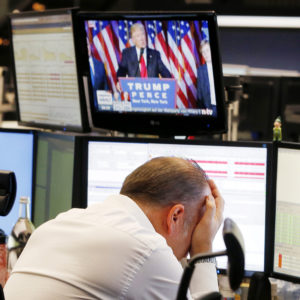When a sudden and unexpected event ambushes financial markets — the election of Donald J. Trump to the U.S. presidency comes to mind — it’s useful to remind ourselves of the distinction between risk and uncertainty.
We can put a price on risk. Because someone’s figured out how much each of us needs to kick in to ensure that everyone is covered in an accident, we can all buy car insurance. The same principle holds for stocks, bonds and any other financial instrument you can think of, albeit with much less precision. After the invention of the automobile, some smart analyst figured out that lower sales of buggy whips were inevitable, but it didn’t happen overnight.
Uncertainty is a different beast entirely. It’s the financial market equivalent of Donald Rumsfeld’s famous “unknown unknowns.” Carl Weinberg, the chief economist at High-Frequency Economics, put it as succinctly as anyone has in a note to clients this morning.
“No one knows yet what is coming and when, or even if it is coming at all,” Weinberg wrote. He added, as if apologizing to clients, “We have been thrown into a period of uncertainty. That is the best we can offer you this morning.”
So, the response of financial markets is to hedge by bidding down the price of financial assets. Asian markets plunged on the news, and European ones followed them downward. Wall Street did the same before pulling up, and starting to differentiate. Remember the buggy whips?
Risk and Uncertainty
Well, this morning, investors started distinguishing between different kinds of assets. Big construction and machinery firms might benefit from greater federal spending on infrastructure, one of the few areas where Republicans and Democrats might find agreement, so their stocks rose. Pharmaceutical makers got a fillip on the prospect that health care regulations might be relaxed.
These distinctions become possible as uncertainty (the unknown unknown) turns into risk (something that can be priced). Nowhere was this change more vivid than in the 10-year Treasury, a benchmark for financial markets around the world. As Trump secured his grip on the White House through the night, it plunged in value, but recovered in the first few hours of trading in the United States as investors processed the reality: if policy does move the way Trump talked, it means greater budget deficits to fund a tax cut, and — let’s not forget — the wall on the Mexican border.
More uncertainty is utterly inevitable because these distinctions that investors make can only come with more information about what a Trump administration plans to do.
The decision by British voters to leave the European Union in June shocked financial markets as well, and created more questions than it answered. That decision will require Britain to negotiate free trade agreements, establish new rules on immigration and figure how London’s financial center can adapt, and as Prime Minister Theresa May is finding out, it’s hard to be definitive about any of those things.
Protectionism at Issue
So too will the world have to figure out whether Trump is truly the protectionist or foe of immigration that he was during the campaign.
“We are still learning if Brexit means Brexit, and it will probably take some time too to discover if ‘tariffs mean tariffs,’ and by how much deportations will increase, and more generally will this be a ‘soft or hard’ Trump presidency,” Gabriel Stern, head of global macro research at Oxford Economics wrote in a research note this morning.
Financial markets being globally integrated systems that developed in response to world trade, Trump’s outlook on international commerce will be the subject of considerable scrutiny in the future.
“A downbeat mood could last several weeks but, as noted above, the medium-term implications for markets depend on the actual policies of President Trump and what can be negotiated through Congress,” Standard Life Investments wrote its clients.
Volatility Is Inevitable
Forget new free-trade agreements. Can Trump really renegotiate the North American Free Trade Agreement? It was hard-fought the first time around. How about double-digit tariffs on goods from Mexico and China? The president has a lot of discretion to take steps like these without a word from Congress.
“Some kind of protectionism measures look inevitable and there can be little doubt that a less open U.S. trade regime could potentially harm the U.S. economy (higher tariffs on foreign imports would squeeze real incomes and even tip the economy towards recession) and damage export and GDP growth in its trading partners,” the global bank HSBC wrote its clients this morning.
Peter Navarro, a University of California-Irvine professor of economics and public policy, told Politico that Trump will choose his U.S. trade representative with one quality in mind. “I can assure you it will be the toughest, smartest SOB on trade that Mr. Trump can find,” Navarro said earlier this year. “That’s the job description.”
Navarro’s comment suggests that we should all appreciate why volatility could become more the norm than we’re used to as long as the trajectory of a Trump administration is unclear. If markets see uncertainty and not risk, then volatility is likely. They can adapt, but expect a bumpy ride.

